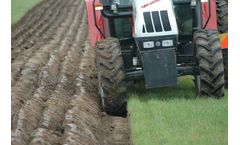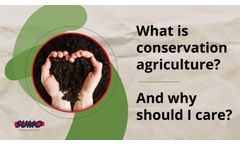Soil Tillage Articles & Analysis
19 articles found
Soil compaction is becoming a major issue worldwide. Not only in the Netherlands but globally the soil is deteriorating very badly. Soil compaction is a form of soil degradation, in which the soil structure is lost because the soil is compressed. This global problem is still underestimated and causes problems for agriculture, nature, and climate. Furthermore, soil compaction leads to loss of ...
Such methods can lead to savings on labour, fuel, and maintenance. Minimum or zero tillage means soils are cultivated as little as possible which should help farmers to save time and reduce wear and tear on machinery. ...
DTS strip-till seeding is a conservation agriculture system that uses a minimum tillage approach that improves root development and soil carrying capacity. It combines the soil drying and warming benefits of conventional tillage with the soil-protecting advantages of no-till by disturbing only the portion of the ...
Agricultural purposes include, but are not limited to, idling land for conservation uses (e.g., habitat; pollinator and wildlife management; and water storage, supply, and flood management); irrigation tailwater storage; crawfish farming; cranberry bogs; nutrient retention; and idling land for soil recovery following natural disasters like hurricanes and drought. ...
Common factors that affect suggested N rates are timing of application, climate, crop rotation, tillage system and soil productivity. When using too little N, a crop such as corn results in lower yields and reduced profits. ...
Its surrounding hilly landscape is covered with rich brown forest soil. This landscape is, however, prone to soil erosion -in particular, rills develop when soil is weakened by excessive tillage and exposed to intense rainstorms. If not carefully managed, runoff and soil erosion threaten not only the ...
BySyngenta
Such an effect is consistent with a net loss of soil organic C recently observed for the Morrow Plots, America's oldest experiment field, after 40 to 50 yr of synthetic N fertilization that substantially exceeded grain N removal. A similar decline in total soil N is reported herein for the same site and would be expected from the predominantly organic occurrence ...
Tillage systems may influence soil microbial communities and N mineralization enzymes through alterations in total soil C and N. Soil aggregates of different sizes provide diverse microhabitats for microorganisms and therefore influence soil enzyme activities. ...
We evaluated the 21-yr effect of tillage and cropping sequence on dryland grain and biomass (stems + leaves) yields of spring wheat (Triticum aestivum L.), barley (Hordeum vulgare L.), and pea (Pisum sativum L.) and soil organic matter at the 0- to 20-cm depth in eastern Montana, USA. ...
In dry land areas of the Mediterranean region, farmers' decisions are particularly difficult due to irregular rainfall. Yield risk, soil erosion and desertification are important problems. Decision-making behaviour of farmers is supposed to incorporate a particular concern in the adoption of strategies to decrease income variability, to conserve soil and to ...
Compacted soils have been found in intensively cultivated vegetable crop regions of Central Wisconsin, resulting in the wide scale use of subsoil tillage by growers. The goal of this project was to assess potato (Solanum tuberosum L.) yield and quality response to soil compaction and subsoil tillage. Potato quality factors ...
Continuous no-till (NT) results in soil improvements, primarily in the surface 5 cm of soil. One-time tillage may improve NT systems by inverting surface soil with less improved deeper soil. Research was conducted to determine the change in abundance of soil microbial groups after a one-time ...
Little is known about soil redistribution by tillage and its impact on the properties of soil profiles with thin soil layers on hillslopes. ...
No tillage often delays soil warming and drying, thus sowing too early in the spring may compromise seed viability due to prolonged exposure to cold and wet soil in the northern Corn Belt. ...
Tillage systems may affect soil C sequestration, with a potential impact on crop productivity or organic matter mineralization. ...
Yield potential is often constrained by severe water deficits during grain fill which might be alleviated by reducing runoff throughout the season using microbasin or tie-ridge tillage. Research was conducted to determine the effects of time of tie-ridge tillage and planting method on soil water availability and on the performance of these three ...
A 7-yr study (1977–1982, and 1985) to evaluate tillage and tillage timing effects on soil water storage, crop water use, and grain yield of winter wheat (Triticum aestivum L.) and spring green pea (Pisum sativum L.) in rotation, was conducted near Pendleton, OR. Treatments included (i) fall plow (FP)–fall moldboard plow after wheat and after pea, ...
Conservation tillage is a commonly adopted best management practice for reducing runoff and erosion, and increasing infiltration. ...
A number of policy tools are used to reduce soil erosion from agricultural lands in the USA, including education and technical assistance, financial assistance, land retirement, and conservation compliance requirements. Education and technical assistance by public and private sources can be effective in promoting the adoption of conservation tillage by farmers ...








